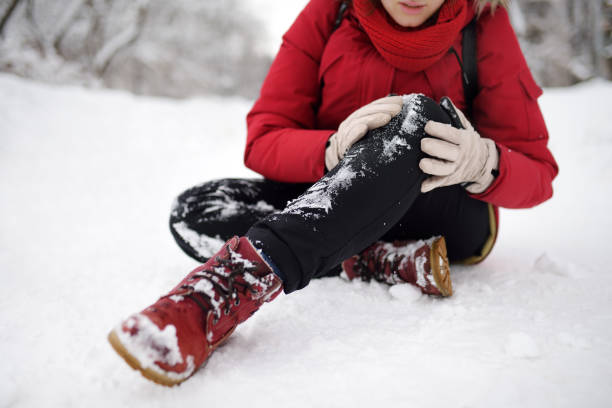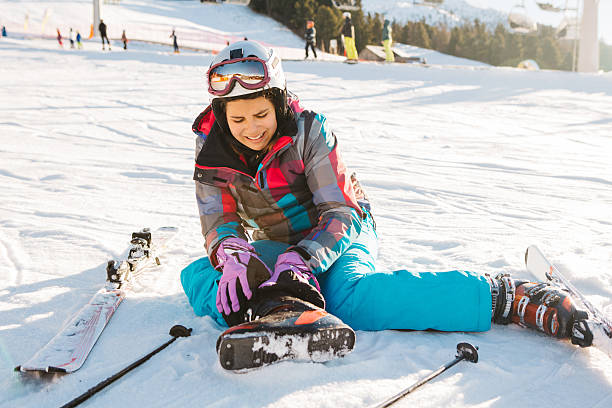Winter sports are fun, but they can also be very dangerous. Some injuries are easy to prevent, while others require medical treatment and can even be life-threatening.
The best way to avoid injury is to practice good technique and listen to your body. Some tips include: Never ski or snowboard beyond your skill level, stay with a group of friends and take frequent breaks.

Muscle Strains
While a few minor falls are to be expected during winter sports, it is important to do everything possible to avoid major injuries. “Elite level ice skaters, hockey players and snow skiers/boarders undergo huge amounts of core strengthening, hip strengthening and stability training before they hit the ice or slopes,” says Dr. Ganley. “They are in peak condition, so the ligaments and muscles are more resilient to injury.”
A muscle strain (also known as a pulled muscle) occurs when you stretch or use your muscles too hard or quickly. When a muscle is strained, the strands of fiber that make up the muscle are damaged.
The severity of a muscle strain is graded and can range from mild to severe. A grade 1 muscle strain means only a few fibers are injured and the injured muscle is painful but has normal strength. A grade 2 strain means the injured muscle has more damaged fibers and is more tender with noticeable weakness. A grade 3 strain is the most severe and means all fibers have been torn. This causes significant pain, swelling and bruising.
Most of the time, a grade 1 or 2 muscle strain will heal on their own with at-home treatment. However, if the symptoms are severe or don’t improve, call podiatrist in Kennington or go to Bendigo Podiatry immediately.
Muscle Tears
During sports, muscles contract and relax to propel your body through the movement you are performing. When a sudden increase in the forces applied to a muscle exceeds its elasticity, it can tear. These injuries are referred to as muscle strains, and they can occur anywhere in the body.
To prevent a strain, always warm up before your activity and stretch. You should also listen to your body and stop when you’re tired. This will give overworked muscles a chance to rest and recover. You should also avoid doing the same motion over and over again, especially if it’s repetitive. If you jump up and down for rebounds while playing basketball, for example, this will weaken your ankles and eventually lead to a stress fracture.
If you’re injured during a winter sport, it’s important to seek medical attention as soon as possible. If your injury is severe, you may need surgery to fix it.
Some types of winter sports are more likely to cause severe injuries than others. Cole sees a lot of sledding and snowmobiling injuries in younger patients, and downhill skiing injuries in middle-aged adults. Older adults also have a higher risk of broken bones in winter sports accidents.

Bone Fractures
When you participate in winter sports, there’s a chance that you could break a bone. This is a serious injury that requires immediate medical attention. The most common sign of a fracture is a snapping noise followed by pain, bruising, and swelling. It is also important to note if the injured body part looks different than the other body parts. This is called a compound fracture and can be very dangerous.
If you think someone has a fracture, call emergency help immediately and do not move the broken area. To check for bleeding, press firmly over the skin beyond the site of the break for about 2 seconds. The skin should first blanch, then pink up if blood is present.
To prevent bone injuries, try warming up before going for a ski or snowboarding session. A good warm up should consist of a brisk walk to get the blood flowing, and stretching your muscles. It is also important to use proper skiing and snowboarding equipment to avoid abrasions, cuts, and strains. The best way to prevent knee injuries is by strengthening the surrounding muscles and tendons. For example, doing simple exercises such as side-lying external rotation, and counter half push-ups can help improve knee strength and stability. Performing these exercises can also help prevent the common condition of arthritis.
Concussion
While the media often references concussions in football, they can occur in any sport and even more so during winter sports such as skiing, snowboarding, ice skating and hockey. These injuries are a result of the combination of high speeds and slippery surfaces that make the winter environment perfect for head injury.
A traumatic brain injury, a concussion can lead to dizziness, blurred vision, vomiting and confusion. It can also be very dangerous if a person falls or hits their head and is not treated properly. Symptoms of a concussion are very similar to those experienced in other forms of trauma, so it is important to recognize them and seek immediate medical attention if they appear.
Knee – The knee absorbs most of the shock during everyday activity, and this makes it particularly vulnerable in winter sports like skiing or ice skating. Knee injuries include sprains, tears, ligament damage and dislocations. One unique winter injury is skier’s thumb, a torn ligament in the thumb that occurs when a skier falls and attempts to hold on to the pole with their hand.
Fortunately, most knee injuries can be avoided by wearing proper shoes and using the correct techniques during your chosen winter sports. It’s also important to stretch and warm up before engaging in any winter activities, because cold muscles and ligaments are more prone to injury. Lastly, it is important to know when your body is tired and stop playing.
